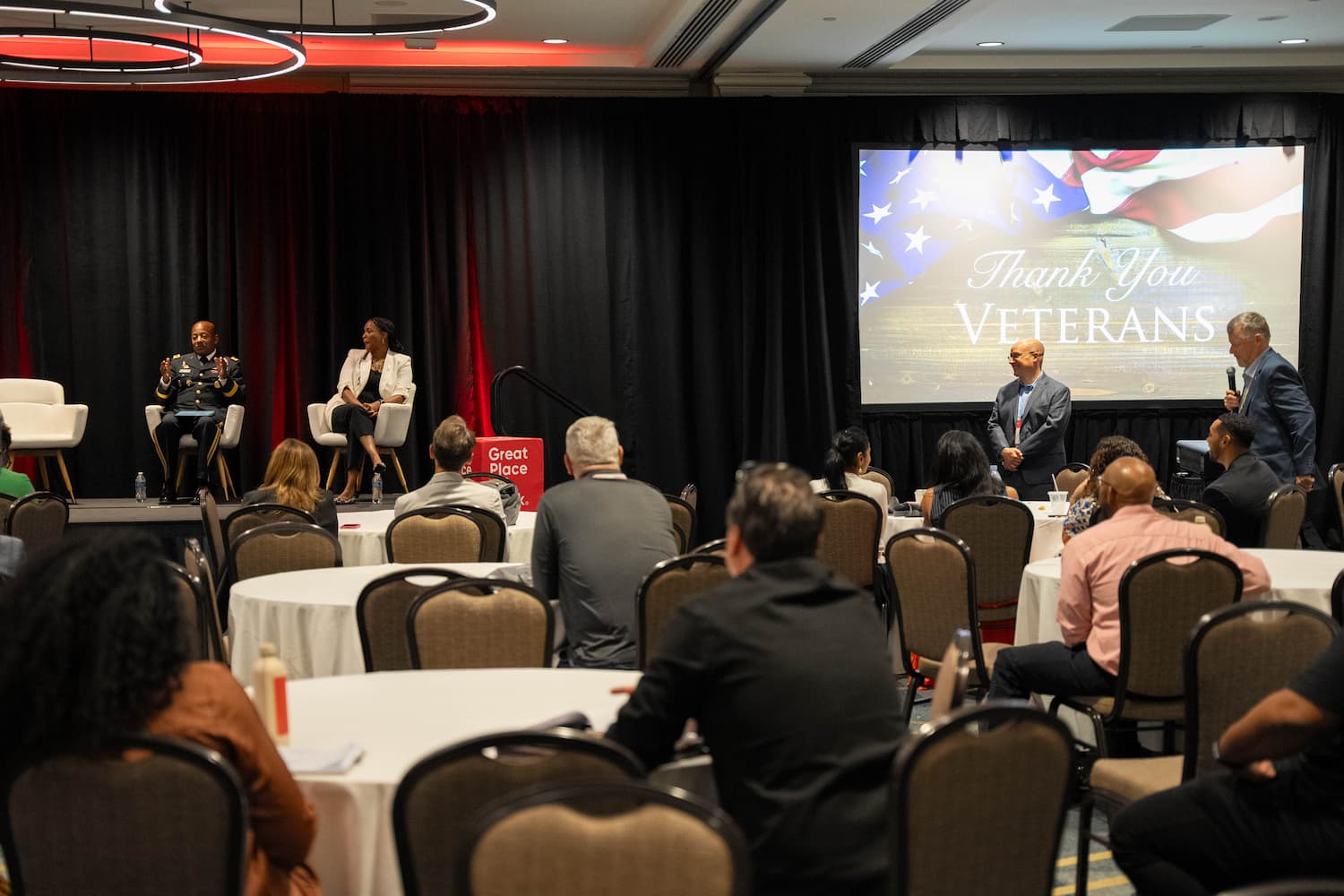Here’s how you can flip the script to support former service members and leverage their unique and valuable skills.
Why do veterans struggle to find adequate employment when transitioning to the civilian workforce?
There are some common myths about former service members that may lead employers to discount veterans’ experience and skills — but that’s a mistake, according to Alveda Williams, chief inclusion officer at Dow.
Williams joined Bob Ferrell, executive vice president, global HR and diversity, equity and inclusion at World Wide Technology — himself a veteran and retired three-star general — for a discussion about veterans in the workplace at the 2024 For All Summit™ in New Orleans.
Debunked myths about veterans in the workforce
Williams started the conversation outlining four common misconceptions about veterans and the experience they bring to a civilian role:
1. Veterans are more susceptible to turnover
“There’s this myth around turnover, that veterans don’t get acclimated or integrated well,” Williams says. The idea doesn’t pass muster when you dig into the data. Veterans remain with their initial post-service employer 8.3% longer than non-veterans, according to LinkedIn data.
2. Veterans’ military experience doesn’t translate to civilian roles
Williams and Ferrell acknowledge that there are new skills veterans must develop when working at a for-profit organization, but argue that veterans also bring unique and highly valuable experience to a role.
“We run big manufacturing and production facilities, often with pretty dangerous stuff running through the pipes,” Williams says about the experience needed to work at Dow. “One of the things that’s inherent in our culture is our safety culture — veterans, they know the power of one bad decision and what a difference that can make. It’s all about tapping into what they’re capable of and translating that into an environment for them where it makes sense.”
As it relates to technology, Ferrell notes seeing more veterans come to World Wide Technology with skills in areas like cybersecurity.
3. All veterans have the same strengths and weaknesses when joining your organization
Like any other demographic group, veterans are not a monolith but instead contain a vast wealth of diverse experiences. “They’re made up of a bunch of different communities, a bunch of different backgrounds and experiences,” Williams says. “We need to be sensitive to that and meet people where they are.”
For example, while veterans are more likely to experience post-traumatic stress disorder than their civilian co-workers, it’s a mistake to assume that every former service member has a mental health issue.
“We need to acknowledge where that’s true and dispel that as a sort of catch-all myth for the entire community,” Williams says.
4. Veterans only need support during the hiring process
While lots of attention is paid to helping veterans navigate the transition into the civilian workforce, they might still need support after getting hired.
“Just like any other employee, we need to rally around them, provide the support that they need so that they can be successful in our organizations and thrive,” Williams says. That could include starting an employee resource group (ERG) or developing targeted programming to help them translate their military experience into civilian skills.
In addition to being purposeful in hiring veterans, Ferrell says employers must be purposeful in how they embrace veterans once they join the organization. Ferrell recommends connecting newly hired veterans to your veterans ERG or to other veterans in your organization as a part of the onboarding process.
How you can support veterans in your workforce
Here’s how World Wide Technology and Dow are using their company resources to build a welcoming workplace for veterans that support their transition to a civilian role:
Partnering with external groups
“There are multiple programs that we are connected to,” Ferrell says, naming the Tap program, SkillBridge, NPower, and Hiring Our Heroes as examples. These partners work with companies like World Wide Technology to give veterans on-the-job experience and sometimes place them in jobs at the company. World Wide Technology’s veterans ERG also has a strategic partnership with My Warriors Place, a retreat center for veterans and their families that offers recovery and coping programs
“A big key in the entire process of hiring vets is to meet them where they need you,” Ferrell says. That might include help with preparing résumés or tips on how to negotiate salaries.
To really increase the number of veterans joining your organization, Ferrell recommends adding military veterans to your talent acquisition team and taking advantage of their large networks. Veterans in your organization can reach over the fence and use their network to identify other highly skilled veterans as candidates for hire.
Invest in employee resource groups
Dow in particular places value on its ERGs with more than 60% of its current workforce participating in one of its 10 resource groups. One of its groups is called the Veterans Network or VetNet and is an essential resource for leaders to understand veterans’ experiences at the company.
It was with input from its VetNet group that Dow developed a military degree equivalence program, giving former service members with a rank of E-6 or higher credit for their service, equivalent to having earned a bachelor’s degree. For a materials science company like Dow, where degrees are often required for the work, this step made a huge difference.
Williams gives the example of one Dow employee who had worked at the company for 16 years who came with experience in the Naval Nuclear Program. “Because of military degree equivalence, he’s now able to lead one of our key projects with small modular nuclear reactors,” Williams said.
World Wide Technnology's veterans ERG — VETS — provides a rally point for veterans to gather for support, and supports purposeful accommodation of those who continue to serve in the National Guard or Reserves. VETS also brings education and awareness of veterans' matters to the broader workforce at the company.
Use company resources to increase visibility for vets
World Wide Technology and Dow commit company resources to celebrate veterans and their service, both internally and externally.
World Wide Technology partnered with the Honor Flight Network, an organization that transports veterans to Washington, D.C., to visit the memorials and monuments honoring them and their service. For one veteran who didn’t have family members to accompany him on the journey, more than 50 World Wide co-wokers rallied to hand write cards thanking him for his service.
Dow took advantage of its partnership with NASCAR to wrap the No.3 car it sponsors with a design to honor the service of 2,000 veterans, both employees who served and employees’ family members who served. “There is nothing more powerful than when this car gets unveiled, to see the employees going and looking and finding their names or their great-grandfather's name,” Williams says.
Ferrell says that individual leaders can also have an impact by taking a personal interest in their Veterans. “When you see a Veteran, ask him or her how they’re doing,” he says. “Transitioning into the corporate world is not easy. Ask how they’re doing and then figure out how you can give back and help.”











